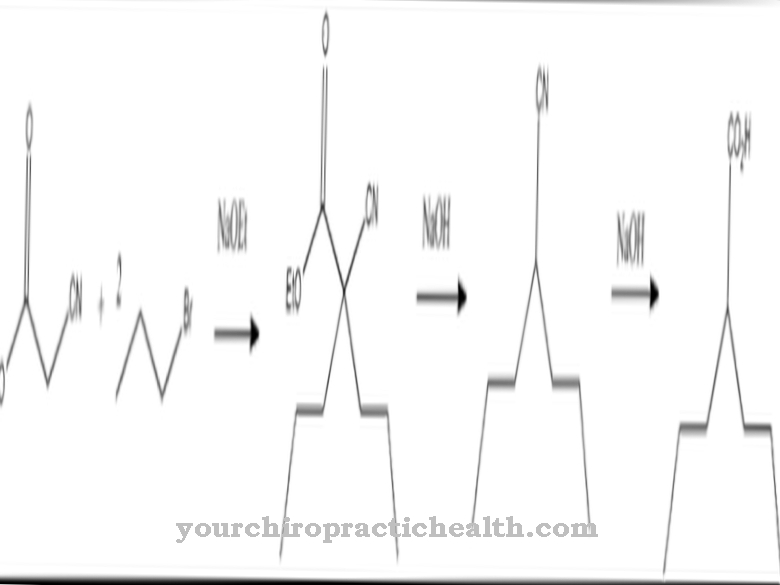Carbidopa is a drug from the drug group of L-DOPA decarboxylase inhibitors. The drug is used to treat Parkinson's disease and is on the WHO list of essential drugs.
What is carbidopa?

Carbidopa is a selective decarboxylase inhibitor. Decarboxylase inhibitors are so-called competitive inhibitors of DOPA decarboxylase. This is an enzyme that delays the breakdown of L-dopa. L-dopa, also called levodopa, is a substance that acts as a precursor for melanin, adrenaline, dopamine, and noradrenaline.
The drug was discovered in the 1950s. In 1961, 1963, 1969 and 1971 the patent was granted by Merck & Co. Inc. Carbidopa is usually available on the market in combination with the drug levodopa. Carbidopa is used with levodopa to treat Parkinson's disease.
Pharmacological effect
Carbidopa selectively inhibits decarboxylase. In this way, the drug in the periphery prevents the conversion of L-DOPA to dopamine. Since carbidopa cannot break the blood-brain barrier, the conversion of L-DOPA to dopamine in the brain remains unaffected by the process.
Medical application & use
Carbidopa is used to treat Parkinson's disease. Parkinson's disease is a neurodegenerative disease that progresses slowly. Characteristic is the death of the nerve cells in the substantia nigra in the midbrain that produce dopamine. This leads to a deficiency in the messenger substance dopamine and ultimately to a reduction in the activating effect of the basal ganglia on the cortex of the cerebrum. The main symptoms of Parkinson's disease are muscle rigidity, slowed movements, muscle tremors, immobility and postural instabilities.
Parkinson's disease is usually treated with L-DOPA preparations. L-DOPA is a precursor in the biosynthesis of dopamine. After passing the blood-brain barrier, L-DOPA is metabolized to dopamine in the brain. This develops the desired pharmacological effect and leads to an alleviation of the symptoms. Levodopa is one of the so-called prodrugs.
The L-DOPA decarboxylase inhibitor carbidopa is used so that the substance is not converted in the periphery. Without the inhibition of peripheral decarboxylation by carbidopa, 95 percent of the administered L-DOPA would already be metabolized outside the brain. The dose of L-DOPA can be reduced by adding carbidopa. This also means there are fewer side effects. Patients receiving a combination of L-DOPA and carbidopa are less likely to have nocturia, tachycardia, or orthostatic dysregulations.
You can find your medication here
➔ Medicines to calm down and strengthen nervesRisks & side effects
However, side effects can also arise from taking carbidopa. For example, nausea and vomiting can occur. Schizophrenia-like symptoms are also observed. Here a distinction can be made between positive and negative symptoms. The positive symptoms appear in addition to the normal personality. These include delusions, thought disorders, and ego disorders. Negative symptoms relate to drive, psychomotor skills, thinking and affect. Affect depletion develops. The ability to experience emotional experiences is reduced. The affected person's psychomotor skills are reduced. The facial expressions and gestures of the patients appear rigid. The drive is also reduced. Thought is empty, unimaginative and impoverished. Often these symptoms are complemented by cognitive limitations.
In addition to experiencing schizophrenia-like symptoms, people may also feel confused or have nightmares. Sleep disorders can also occur acutely. Akinesia can develop with long-term medication. Akinesia is pathological immobility. In Parkinson's disease, this phenomenon is also known as end-of-dose akinesia. Here, the decrease in movement occurs at the end of the duration of the effect of an ingested dose of the Parkinson's medication.
Another side effect of long-term medication with carbidopa is so-called freezing. In neurology, the term freezing describes sudden movement blocks. The patients freeze in the midst of the movement and can no longer move. Furthermore, paroxysmal on / off phenomena can occur. The on / off phenomenon is characterized by a sudden change from good mobility to absolute immobility. The phenomena can last from minutes to hours. The exact cause has not yet been clarified.
Furthermore, hyperkinesia and dyskinesia can develop with long-term use of carbidopa. In hyperkinesis, mobility is pathologically increased. This manifests itself in the form of involuntary, sudden and unpredictable movements of the face, trunk, neck or extremities. Dyskinesia is also a disorder of normal movement. In Parkinson's disease, dyskinesias appear as unwanted excessive movements.
Caution should be exercised when combining levodopa and carbidopa with tricyclic antidepressants. In individual cases a life-threatening drop in blood pressure occurs. In contrast, a combination of drugs from the group of active substances called MAO inhibitors can lead to a critical rise in blood pressure.
It should be noted that metoclopramide speeds up gastric emptying, thus increasing the effects of carbidopa and levodopa. Taking a protein-rich meal at the same time can reduce the effectiveness of the combination product. The same applies to the simultaneous use of iron supplements. Iron supplements should therefore always be taken at least two hours before or at the earliest two hours after the administration of the active ingredient combination.
























.jpg)



